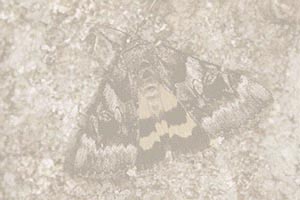|
More About
Maps & images
Over the past several decades, we have been assembling a database of locality records for Nearctic Catocala for
inclusion in the MONA Fascicle. A majority of these locality records represent pinned specimens in institutional and/or
private collections, although a rapidly growing subset
represents records harvested from iNaturalist observations. Each dot on one of the Catocala maps represents an
occurrence record for a given
species, and each occurence record usually reflects many specimens. Think of the dots as "data uniqued
by taxon and locality" -- the 95,000 records presently in the database yield 18,000 dots, and the total number of specimens/images
examined to produce the database is well into six digits.
For the United States, and for most of the pinned specimen records gathered prior to the 2020s, the occurrence
records have been
georeferenced at the
US county centroid level. For Canada and Mexico, the pinned specimen records are georeferenced to the town or actual locality.
The process for iNaturalist records is as follows.
During each field season, Bob tracks/IDs the incoming observations of adults, and Larry tracks/IDs those for larvae.
At the start of each calendar year, we download the prior years' iNaturalist records for Catocala and hold a
reconciliation party in which we try to verify the identities for records that have been taken to the species level,
and identify as many specimens as reasonable that have not
been taken to the species level.
The records are then sorted by taxon and latitude/longitude, uniqued
at the 0.1 degree level of latitude/longitude (yields aggregate dots with a radius of circa 5 miles), and added to the MONA database.
The dots on the maps come in three sizes based on our confidence in the records: the largest dots represent specimens/images that one and usually more of
the MONA co-authors have reviewed; the mid-sized dots
represent records not yet fully reviewed; the smallest dots are literature-only records (which are typically not readily
traced to a specimen). Dots that are filled in with bright yellow represent specimen(s) for which mitochondrial DNA (mtDNA) barcodes have
also been generated. Our requirement for inclusion in the MONA database is either an identifiable specimen or an identifiable image, we do not include
verbal records or records lacking suitably granular geographic attribution.
Images of the larvae presented for each of the Catocala species come primarily from either breeding conducted ex ovis from wild-captured
females, or from larvae collected in the field and subsequently reared to adults. Typically for each larva presented in the species accounts, there will be
a lateral (or dorso-lateral) view of the body, a head capsule view, and a view of the venter (underside), since in many instances the ventral pattern helps to narrow down
species identity. The image captions identify the general locality, year, and either the brood rearing number (if ex ovis) or the
associated native food plant (if field collected), and the photographer.
The Authors
There are presently five co-authors working toward completing the MONA Catocala Fascicle -- Larry Gall, Bob Borth, Hugo Kons, David Hawks, Nicole Palffy-Muhoray -- and
this website is primarily the work of the first two.
Larry Gall is the Senior Collections Manager for the Entomology Division at the Yale Peabody Museum (Connecticut). He has been conducting
systematic research on Catocala since the 1980s, with a focus on rearing/documenting the immature stages of the Nearctic species and as many of the
Palearctic species as possible. For MONA he has visited, identified and/or recurated the Catocala holdings of more than one hundred institutional collections
in North America and Europe. His field work centers on New England, with occasional forays elsewhere for elusive taxa.
Bob Borth is a Certified Public Accountant (CPA) with a practice in Wisconsin and Florida. Since the early 2000s, he has been spearheading
genetic research on Catocala with a focus on mtDNA barcoding of all Nearctic and Palearctic species.
He has described a number of new Catocala species from both geographic regions, as well as new species in related genera such as Eudocima.
Bob has traveled widely throughout the United States for mtDNA sampling and life history studies, and is
the co-author doing most of the real-time monitoring of iNaturalist Catocala observations.
Hugo Kons is a former technician for the American Entomological Institute (Florida). Over the same timeframe as Bob, he has been closely involved in mtDNA work but also
has produced high-quality genitalic dissections/images for all the Nearctic and Palearctic species, and has likewise described
a number of new species. He is based in Wisconsin where he is conducting
intensive faunal sampling and monitoring of Lepidoptera.
David Hawks is recently retired from the Entomology Department at the University of California at Riverside. He has extensively studied the
Catocala of the southwestern USA, and has worked alongside Larry conducting systematic work since the 1980s. He currently resides in Arizona, and is also a coleopterist
with particular expertise in scarabs, notably Chrysina and other melolonthines.
Nicole Palffy-Muhoray is the Assistant Director for Student Programs at the Yale Peabody Museum (Connecticut). She holds a doctoral degree in linguistics, is a
self-taught naturalist/biologist, and worked as a curatorial assistant in the Entomology Division throughout the 2010s. She is currently developing
morphological keys for the MONA Fascicle, and also does field work in southern New England.
|
